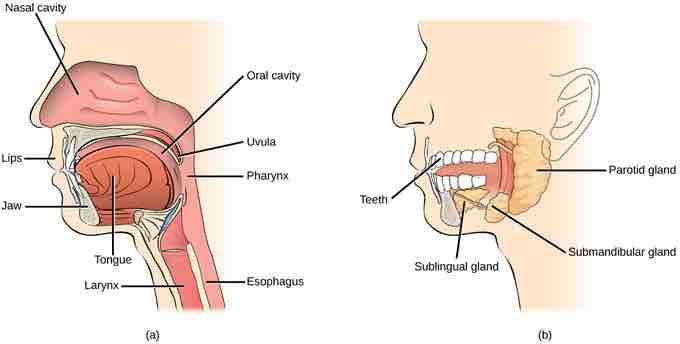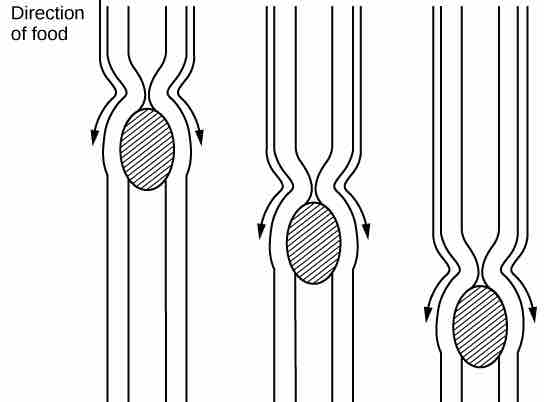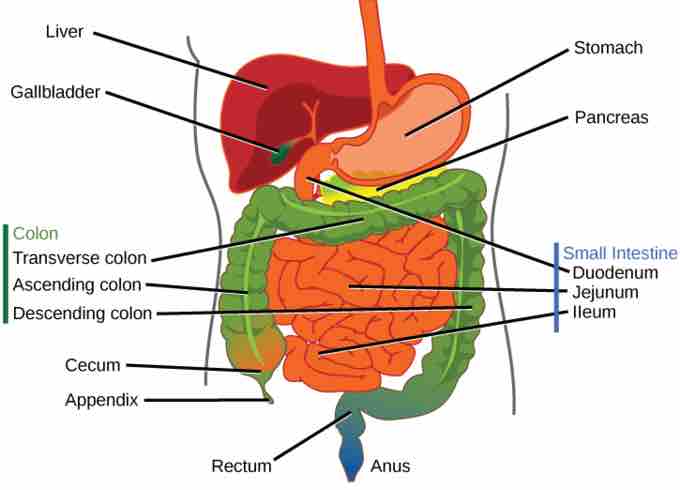Parts of the Digestive System
The vertebrate digestive system is designed to facilitate the transformation of food matter into the nutrient components that sustain organisms. The upper gastrointestinal tract includes the oral cavity, esophagus, and stomach.
Oral Cavity
The oral cavity, or mouth, is the point of entry of food into the digestive system . The food is broken into smaller particles by mastication, the chewing action of the teeth. All mammals have teeth and can chew their food.

Digestion begins in the oral cavity
Digestion of food begins in the (a) oral cavity. Food is masticated by teeth and moistened by saliva secreted from the (b) salivary glands. Enzymes in the saliva begin to digest starches and fats. With the help of the tongue, the resulting bolus is moved into the esophagus by swallowing.
The extensive chemical process of digestion begins in the mouth. As food is chewed, saliva, produced by the salivary glands, mixes with the food. Saliva is a watery substance produced in the mouths of many animals. There are three major glands that secrete saliva: the parotid, the submandibular, and the sublingual. Saliva contains mucus that moistens food and buffers the pH of the food. Saliva also contains immunoglobulins and lysozymes, which have antibacterial action to reduce tooth decay by inhibiting growth of some bacteria. In addition, saliva contains an enzyme called salivary amylase that begins the process of converting starches in the food into a disaccharide called maltose. Another enzyme, lipase, is produced by the cells in the tongue. It is a member of a class of enzymes that can break down triglycerides. Lingual lipase begins the breakdown of fat components in the food. The chewing and wetting action provided by the teeth and saliva shape the food into a mass called the bolus for swallowing. The tongue aids in swallowing by moving the bolus from the mouth into the pharynx. The pharynx opens to two passageways: the trachea, which leads to the lungs, and the esophagus, which leads to the stomach. The tracheal opening, the glottis, is covered by a cartilaginous flap, the epiglottis. When swallowing, the epiglottis closes the glottis, allowing food to pass into the esophagus, not into the trachea, preventing food from reaching the lungs.
Esophagus
The esophagus is a tubular organ connecting the mouth to the stomach. The chewed and softened food passes through the esophagus after being swallowed. The smooth muscles of the esophagus undergo a series of wave like movements called peristalsis that push the food toward the stomach . The peristalsis wave is unidirectional: it moves food from the mouth to the stomach; reverse movement is not possible. The peristaltic movement of the esophagus is an involuntary reflex, taking place in response to the act of swallowing.

Esophagus
The esophagus transfers food from the mouth to the stomach through peristaltic movements.
Stomach
A large part of digestion occurs in the stomach . The stomach, a saclike organ, secretes gastric digestive juices. The pH in the stomach is between 1.5 and 2.5. This highly-acidic environment is required for the chemical breakdown of food and the extraction of nutrients. When empty, the stomach is a rather small organ; however, it can expand to up to 20 times its resting size when filled with food. This characteristic is particularly useful for animals that need to eat when food is available.

Stomach digestion
The human stomach has an extremely acidic environment where most of the protein gets digested.
The stomach is also the major site for protein digestion in animals other than ruminants. Protein digestion is mediated in the stomach chamber by an enzyme called pepsin, which is secreted by the chief cells in the stomach in an inactive form called pepsinogen. Another cell type, parietal cells, secrete hydrogen and chloride ions, which combine in the lumen to form hydrochloric acid, the primary acidic component of the stomach juices. Hydrochloric acid helps to convert the inactive pepsinogen to pepsin. The highly-acidic environment also kills many microorganisms in the food and, combined with the action of the enzyme pepsin, results in the hydrolysis of protein in the food. Chemical digestion is facilitated by the churning action of the stomach. Contraction and relaxation of smooth muscles mixes the stomach contents about every 20 minutes. The partially-digested food and gastric juice mixture is called chyme. Chyme passes from the stomach to the small intestine. Further protein digestion takes place in the small intestine. Gastric emptying occurs within two to six hours after a meal. Only a small amount of chyme is released into the small intestine at a time. The movement of chyme from the stomach into the small intestine is regulated by the pyloric sphincter.